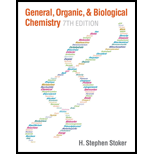
Concept explainers
(a)
Interpretation:
The number of significant figures that the answer must have for the conversion of
Concept Introduction:
A general-problem solving method in which the units under consideration is associated with numbers and are used as a guide in setting up calculations is known as Dimensional analysis. The units are treated the way the numbers are treated in this method. Three steps has to be followed for the Dimensional analysis and they are,
- The known or given quantity has to be identified that includes both numerical and units. The unit of the new quantity that has to be determined.
- Multiply the known or given quantity by one or more required conversion factors so that the unwanted units are cancelled leaving the desired units only.
- The mathematical operation has to be performed as indicated by the conversion factor setup.
If an exact number is present in the conversion of one unit into another, then the answer obtained will have the same number of significant figures as the measurement. If an inexact number is present in the conversion means, then the answer obtained will have same number of significant figures as in measurements or least number of significant figures as in conversion factor.
(b)
Interpretation:
The number of significant figures that the answer must have for the conversion of
Concept Introduction:
A general-problem solving method in which the units under consideration is associated with numbers and are used as a guide in setting up calculations is known as Dimensional analysis. The units are treated the way the numbers are treated in this method. Three steps has to be followed for the Dimensional analysis and they are,
- The known or given quantity has to be identified that includes both numerical and units. The unit of the new quantity that has to be determined.
- Multiply the known or given quantity by one or more required conversion factors so that the unwanted units are cancelled leaving the desired units only.
- The mathematical operation has to be performed as indicated by the conversion factor setup.
If an exact number is present in the conversion of one unit into another, then the answer obtained will have the same number of significant figures as the measurement. If an inexact number is present in the conversion means, then the answer obtained will have same number of significant figures as in measurements or least number of significant figures as in conversion factor.
(c)
Interpretation:
The number of significant figures that the answer must have for the conversion of
Concept Introduction:
A general-problem solving method in which the units under consideration is associated with numbers and are used as a guide in setting up calculations is known as Dimensional analysis. The units are treated the way the numbers are treated in this method. Three steps has to be followed for the Dimensional analysis and they are,
- The known or given quantity has to be identified that includes both numerical and units. The unit of the new quantity that has to be determined.
- Multiply the known or given quantity by one or more required conversion factors so that the unwanted units are cancelled leaving the desired units only.
- The mathematical operation has to be performed as indicated by the conversion factor setup.
If an exact number is present in the conversion of one unit into another, then the answer obtained will have the same number of significant figures as the measurement. If an inexact number is present in the conversion means, then the answer obtained will have same number of significant figures as in measurements or least number of significant figures as in conversion factor.
(d)
Interpretation:
The number of significant figures that the answer must have for the conversion of
Concept Introduction:
A general-problem solving method in which the units under consideration is associated with numbers and are used as a guide in setting up calculations is known as Dimensional analysis. The units are treated the way the numbers are treated in this method. Three steps has to be followed for the Dimensional analysis and they are,
- The known or given quantity has to be identified that includes both numerical and units. The unit of the new quantity that has to be determined.
- Multiply the known or given quantity by one or more required conversion factors so that the unwanted units are cancelled leaving the desired units only.
- The mathematical operation has to be performed as indicated by the conversion factor setup.
If an exact number is present in the conversion of one unit into another, then the answer obtained will have the same number of significant figures as the measurement. If an inexact number is present in the conversion means, then the answer obtained will have same number of significant figures as in measurements or least number of significant figures as in conversion factor.
Want to see the full answer?
Check out a sample textbook solution
Chapter 2 Solutions
GENERAL,ORGANIC,+BIO.CHEM.-MINDTAP
- What is this?arrow_forwardMolecular Biology A-C components of the question are corresponding to attached image labeled 1. D component of the question is corresponding to attached image labeled 2. For a eukaryotic mRNA, the sequences is as follows where AUGrepresents the start codon, the yellow is the Kozak sequence and (XXX) just represents any codonfor an amino acid (no stop codons here). G-cap and polyA tail are not shown A. How long is the peptide produced?B. What is the function (a sentence) of the UAA highlighted in blue?C. If the sequence highlighted in blue were changed from UAA to UAG, how would that affecttranslation? D. (1) The sequence highlighted in yellow above is moved to a new position indicated below. Howwould that affect translation? (2) How long would be the protein produced from this new mRNA? Thank youarrow_forwardMolecular Biology Question Explain why the cell doesn’t need 61 tRNAs (one for each codon). Please help. Thank youarrow_forward
- Molecular Biology You discover a disease causing mutation (indicated by the arrow) that alters splicing of its mRNA. This mutation (a base substitution in the splicing sequence) eliminates a 3’ splice site resulting in the inclusion of the second intron (I2) in the final mRNA. We are going to pretend that this intron is short having only 15 nucleotides (most introns are much longer so this is just to make things simple) with the following sequence shown below in bold. The ( ) indicate the reading frames in the exons; the included intron 2 sequences are in bold. A. Would you expected this change to be harmful? ExplainB. If you were to do gene therapy to fix this problem, briefly explain what type of gene therapy youwould use to correct this. Please help. Thank youarrow_forwardMolecular Biology Question Please help. Thank you Explain what is meant by the term “defective virus.” Explain how a defective virus is able to replicate.arrow_forwardMolecular Biology Explain why changing the codon GGG to GGA should not be harmful. Please help . Thank youarrow_forward
- Stage Percent Time in Hours Interphase .60 14.4 Prophase .20 4.8 Metaphase .10 2.4 Anaphase .06 1.44 Telophase .03 .72 Cytukinesis .01 .24 Can you summarize the results in the chart and explain which phases are faster and why the slower ones are slow?arrow_forwardCan you circle a cell in the different stages of mitosis? 1.prophase 2.metaphase 3.anaphase 4.telophase 5.cytokinesisarrow_forwardWhich microbe does not live part of its lifecycle outside humans? A. Toxoplasma gondii B. Cytomegalovirus C. Francisella tularensis D. Plasmodium falciparum explain your answer thoroughly.arrow_forward
- Select all of the following that the ablation (knockout) or ectopoic expression (gain of function) of Hox can contribute to. Another set of wings in the fruit fly, duplication of fingernails, ectopic ears in mice, excess feathers in duck/quail chimeras, and homeosis of segment 2 to jaw in Hox2a mutantsarrow_forwardSelect all of the following that changes in the MC1R gene can lead to: Changes in spots/stripes in lizards, changes in coat coloration in mice, ectopic ear formation in Siberian hamsters, and red hair in humansarrow_forwardPleiotropic genes are genes that (blank) Cause a swapping of organs/structures, are the result of duplicated sets of chromosomes, never produce protein products, and have more than one purpose/functionarrow_forward
 Nutrition Through The Life CycleHealth & NutritionISBN:9781337919333Author:Brown, Judith E.Publisher:Cengage Learning,
Nutrition Through The Life CycleHealth & NutritionISBN:9781337919333Author:Brown, Judith E.Publisher:Cengage Learning, Principles Of Radiographic Imaging: An Art And A ...Health & NutritionISBN:9781337711067Author:Richard R. Carlton, Arlene M. Adler, Vesna BalacPublisher:Cengage Learning
Principles Of Radiographic Imaging: An Art And A ...Health & NutritionISBN:9781337711067Author:Richard R. Carlton, Arlene M. Adler, Vesna BalacPublisher:Cengage Learning Comprehensive Medical Assisting: Administrative a...NursingISBN:9781305964792Author:Wilburta Q. Lindh, Carol D. Tamparo, Barbara M. Dahl, Julie Morris, Cindy CorreaPublisher:Cengage Learning
Comprehensive Medical Assisting: Administrative a...NursingISBN:9781305964792Author:Wilburta Q. Lindh, Carol D. Tamparo, Barbara M. Dahl, Julie Morris, Cindy CorreaPublisher:Cengage Learning





